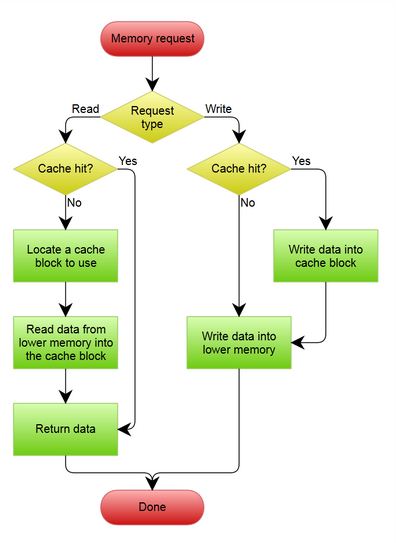Asked By
akm_r
40 points
N/A
Posted on - 10/08/2011

I have hard the name of cache memory but i do not know the function of this memory.
When and in which computer using this memory.
Answered By
rabin
0 points
N/A
#89449
Memory Cache Functions and Usage on a Computer

Hello Akm_r,
Well cache memory is a storage for central processing unit and it handles different task like pages, images, and web address that most of your recent sites visit and gathers and store to a folder in hard disk.
The main function of cache memory is to speed up your working mechanics of computer and it relies of central processing unit and memory. Your computer check if the data is in the storage, If the item is there it is called cache memory.
Hope it is working and clearly for you and it only defines the routine of files which is storage in a memory like for instance you are browsing and internet sites and those sites are stored in cache memory.
Have fun and enjoy,
Rabin
Memory Cache Functions and Usage on a Computer

Hi friend,
Cache memory is a reserve memory for processor. All computers have cache memory. Cache memory stands between main memory (RAM= Random Access Memory) and processor. So users can not use this memory manually. Only processor can use cache memory of a computer.
Cache memory is used for reserve data. Those data or instructions which are needed regularly or processing and which data or instruction are needed to be repeated continually, processor store those data or instruction in cache memory.

In this case computer runs faster and processor can find most necessary data quickly. So it helps to speed up computer.
Memory Cache Functions and Usage on a Computer

In easy words: The main function of cache memory is to speed up the working mechanism of computer and it lies between the main memory and CPU.
Pronounced cache, a special high-speed storage mechanism. It can be either a reserved section of main memory or an independent high-speed storage device. Two types of caching are commonly used in personal computers: memory caching and disk caching.

What is Cache Memory: Cache memory on a computer is a storage container for data recently used by the central processing unit (CPU). The CPU can retrieve the information extremely fast and use it to process the next batch of information. A prime example of a common use of a cache would be the many pages, images and web addresses that your browser routinely gathers and stores in a folder on your hard drive.
Even with faster microprocessors and main memory (RAM) with greater capacities, blockages still occur when information moves between the CPU and RAM. Cache memory is a type of supplemental memory built for faster conveyance of information between these two components of the computer. The computer builds a library of frequently used information into the cache memory. The role of "caching" is to accelerate the speed of your system. Caching not only helps reduce logjams at the CPU and RAM, but also enables users to perform tasks faster because data transmits more rapidly from cache memory to CPU.
Answered By
anmmool
0 points
N/A
#89454
Memory Cache Functions and Usage on a Computer

A Cache Memory is normally used with the processor. It is quite different from main memory or hard disk memory. It stores data temporarily. The processor fetches the data from main memory to cache memory to compute earlier or duplicates of original into cache memory. If a processor required a data for processing and the requested data is contained in the cache memory, then this request can be served quickly by simply reading the cache.
Otherwise processor has to recompute the data from its original storage location. It definitely takes time and process the request slowly. If there are a number of requests and required data is already available in the cache memory then all the request will be processed quickly.
There are three types of following cache memories widely used in CPU on personal computers and Server:
-
An instruction cache is used to enhance the speed of fetching the executable instruction.
-
Data cache fetches the data and store it speedily.
-
The main purpose of “Translation lookaside buffer (TLB)” cache is to do the translation of virtual-to-physical address rapidly for both executable instructions and data.
Memory Cache Functions and Usage on a Computer

Good day, Akm_r!
To make it simple, Cache technology accelerates a slower but larger memory type through the use of a faster but smaller memory type. When the system uses a Cache, a "hit" or a "miss" will happen during the process. A "hit" happens when the system finds an item that it is looking for in the Cache. Otherwise, a "miss" happens, and the system must wait for its search tool to find the item from the larger, slower memory area. A Cache has a maximum storage size that is smaller than the larger storage area. Lastly, the system can have multiple layers of Cache for it to process faster. The only difference in the layers will be the size it can store.

Good luck!
-Justin
Answered By
Sameera
0 points
N/A
#89456
Memory Cache Functions and Usage on a Computer

Cache memory is extremely fast memory that is built into a computer’s CPU or located next to it on a separate chip. The CPU uses cache memory to store instructions that are repeatedly required to run programs, improving overall system speed.
The advantage of cache memory is that the CPU does not have to use the motherboard’s system bus for data transfer. Whenever data must be passed through the system bus, the data transfer speed slows to the motherboard’s capability. The CPU can process data much faster by avoiding the bottleneck created by the system bus.
As it happens, once most programs are open and running, they use very few resources. When these resources are kept in cache, programs can operate more quickly and efficiently. All else being equal, cache is so effective in system performance that a computer running a fast CPU with little cache can have lower benchmarks than a system running a somewhat slower CPU with more cache.
Cache built into the CPU itself is referred to as Level 1 (L1) cache.
Cache that resides on a separate chip next to the CPU is called Level 2 (L2) cache. Some CPUs have both L1 and L2 cache built-in and designate the separate cache chip as Level 3 (L3) cache.
Introductions for cache levels
Level 1 Cache
Typically, a high-speed cache is integrated right into the processor. This is the level 1 cache. One of the main motivations behind this concept is the "locality of reference."
It means that a location just accessed by the CPU has a higher probability of being revisited in the short term. So the L1 cache holds the most recent data. When it needs the data again, the microprocessor first checks the L1 cache. Since the data is there, it eliminates the need to go back to the slower main memory. The process is usually two times faster than with the main memory.
Level 2 Cache
Level 2 cache memory, or the secondary cache, on a computer is usually located on a memory card situated close to the processor. It links directly to the central processing unit, and a circuit that is integrated into the motherboard controls it. The circuit is called the L2 controller.
The level 2 cache catches recently used data not in the level 1 cache. The L2 cache on many personal computers enables the processor to get about 95 percent of the information it needs from the cache memory.
Level 3 Cache (Others)
Disk cache is another type of cache memory. It operates at a much slower speed than the other caches, because it reads data from the computer's hard drive and stores it on RAM. Software programs like DOS use it. Just as RAM is slower than L1 and L2 cache, the disk is much slower than RAM.
Often, personal computer peripherals are cached using the computer's RAM. This is a peripheral cache and operates much the same way as disk cache. For example, a DVD-ROM may be cache using the system's RAM or even the disk. Either caching method may be faster than the DVD-Rom drive.
More Details about cache memory.
Cache that is built into the CPU is faster than separate cache, running at the speed of the microprocessor itself.
However, separate cache is still roughly twice as fast as Random Access Memory (RAM). Cache is more expensive than RAM, but it is well worth getting a CPU and motherboard with built-in cache in order to maximize system performance.















